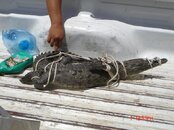I think I would kill over if I were in the water with that guy that close! ""SHIVER" 
You are using an out of date browser. It may not display this or other websites correctly.
You should upgrade or use an alternative browser.
You should upgrade or use an alternative browser.
Salt water crocs
- Thread starter Texasguy
- Start date
Please register or login
Welcome to ScubaBoard, the world's largest scuba diving community. Registration is not required to read the forums, but we encourage you to join. Joining has its benefits and enables you to participate in the discussions.
Benefits of registering include
- Ability to post and comment on topics and discussions.
- A Free photo gallery to share your dive photos with the world.
- You can make this box go away
I am by no means an expert in this, so if I need to be corrected by an authority, I won't mind.
It is my understanding that the term "salt water crocodile" is actually something of a misnomer. Even in Australia, where they are most famous, they should more accurately be called estuarian crocodiles. Their normal habitat is in the brackish (slightly salty) water of estuaries, inland swamps, etc. The can tolerate true salt water and will occasional go into it for various reasons, but it is not their preferred habitat. Thus, although it is possible to encounter one in a typical diving environment, that would be highly unusual, and I would not be even remotely concerned about it.
It is my understanding that the term "salt water crocodile" is actually something of a misnomer. Even in Australia, where they are most famous, they should more accurately be called estuarian crocodiles. Their normal habitat is in the brackish (slightly salty) water of estuaries, inland swamps, etc. The can tolerate true salt water and will occasional go into it for various reasons, but it is not their preferred habitat. Thus, although it is possible to encounter one in a typical diving environment, that would be highly unusual, and I would not be even remotely concerned about it.
- Messages
- 53,669
- Reaction score
- 7,850
- # of dives
- 500 - 999
Well, yeah - Crocs are primarily freshwater reptiles, but since they breathe air instead of water thru gills - they can tolerate saltwater to varying extents, but that's just commuting.
El Graduado
Contributor
- Messages
- 833
- Reaction score
- 1,656
The crocodilians indigenous to Cozumel are the American Crocodile, or Crocodylus acutus andMorelet’s Crocodile, Crocodylus moreletii. The adult C. acutus is light gray in color and have a pointed snout, much narrower than an alligator. The adult C. moreletii is a dark gray-brown and has a much broader snout; however, they are crossbreeding with C. acutus, so now there is a range of snout widths on the island. Both are less aggressive than the Nile and Australian crocs. They can swim around 20 miles per hour in short bursts and run on land at about half that speed. The C. acutus thrives in salt water. C. moreletii prefers the fresh or brackish water inland. On Cozumel, the crocs are protected by law from harassment and hunting. A few months ago, we had the first incident of a croc attacking a human that I ever heard about. It was a local man illegally spearfishing close to shore at sunset in the park waters. It bit his arm and he was taken to the hospital. He was lucky it wasn’t one of the big ones; theC. acutus can grow to over 20 feet long and weigh over 2,000 pounds. C. moreletii doesn’t grow much more than 9 feet, but that is still a sizable animal. If you ever stop by Cabaña del Pescador restaurant across the street from Playa Azul Hotel in the north hotel zone, ask the owner if you can feed the wild seven-footer that sleeps under the wooden patio in back. She’ll come four feet out of the water in a lunge for a chicken leg. For more info on Cozumel’s natural history, see my website, EverythingCozumel.com
Crocs are primarily freshwater reptiles,
+1 to that, this is the place where i did my Initial Dives (Havelock Islands Andamans, India), was there when this crocodile attack at havelock andaman islands « tripp.in NEWS tragedy happened
rarely they venture into deep sea (atleast the havelock ones), eventually i heard the croc was caught is in the singsing since
[video=youtube;ENhhH4PLHfc]http://www.youtube.com/watch?v=ENhhH4PLHfc[/video]
Also known as the Lobster House.
If you ever stop by Cabaña del Pescador restaurant across the street from Playa Azul Hotel in the north hotel zone...
El Graduado
Contributor
- Messages
- 833
- Reaction score
- 1,656
Enrique's place (the one to the north) is called Lobster House Grill as well as Cabaña del Pescador. His brother, Fernando, has the place next door, to the south. Fernado's place is called simply Lobster House (no grill) or Casa Langosta. They split the restaurant into two different business when their father (who founded it) gave it to them. The Croc's name is Gloria. She hangs out at Enrique's.
Texasguy
Contributor
Enrique's place (the one to the north) is called Lobster House Grill as well as Cabaña del Pescador. His brother, Fernando, has the place next door, to the south. Fernado's place is called simply Lobster House (no grill) or Casa Langosta. They split the restaurant into two different business when their father (who founded it) gave it to them. The Croc's name is Gloria. She hangs out at Enrique's.
If only people in the know would be as forthcoming about shore diving information rather than mull over local trivia.





